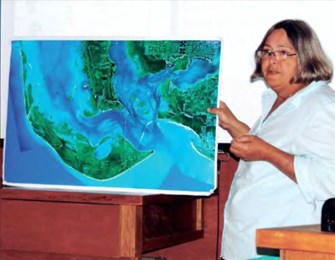
Many thanks to our friends at the “Island Sun” for sharing the following article, written by Jeff Lysiak.
Last week at the SCCF (SanibelCaptiva Conservation Foundation) Nature Center, a lecture on the history of the conservation movement on the islands was delivered by Kristie Anders, SCCF’s education director and longtime local resident. During her 45-minute presentation, Anders shared some background information on several pivotal players and the important dates that helped shape the future of Sanibel.
“This is my favorite story to tell,” Anders told the audience.
Chronicling over a century of preserving paradise, the presentation – A History of Island Conservation: The City That Almost Wasn’t – celebrated the forward thinking of many islanders and visitors, including Theodore Roosevelt and Jay Norwood “Ding” Darling, the establishment of the refuge and the SCCF, leading up to the incorporation and ensuing history of the City of Sanibel.
“What’s the difference between Sanibel and other cities in Southwest Florida? The skyline,” said Anders. “You won’t see many cities along the coast that aren’t dotted with highrises.”
Sharing several historical aerial images taken in the mid-1940s, Anders noted that until the 1950s, Sanibel was mostly a sparsely vegetated island of open grasslands. However, in the years leading up to World War II, the island was being sold to property investors.
One person who came to Sanibel beginning in the 1930s was Darling, whose doctors told him that in order to treat his chronic bronchitis, he should visit a warmer climate during the harsh winters he experienced in Iowa. He and his wife, Penny, who frequently stayed at ‘Tween Waters Inn on Captiva, finally built a permanent home here in 1942.
The nationally known and respected political cartoonist, whose affinity for environmental causes often influenced his work, was one of the leading local voices when it came to helping protect wildlife and preserve land. Darling sent a letter to the federal government requesting that they stop the sale of 2,000 acres of land on Sanibel. Using money from the sale of Federal Duck Stamps, the Sanibel National Wildlife Refuge became established in 1945. It was later rededicated in the name of Darling following his death in 1962.
Mosquitoes were intolerable pests in those days. With mudflats being a key breeding ground for the insect larvae, a five-mile “dam” was built to combat the infestation. That structure eventually became Wildlife Drive, the 4.5 -mile roadway through the center of the refuge.
As air conditioning and fresh water became readily available and affordable, the island’s population began to grow. But plans to bring some 35,000 residential units to Sanibel didn’t sit well with most islanders already living here. In the late 1960s, following the opening of the Sanibel Causeway, local groups of concerned residents began to advocate for preserving environmentally sensitive land. One of those groups became SCCF on October 31, 1967.
“The pressure to develop on Sanibel was enormous,” said Anders, who added that in 1974, a whopping 85 percent of island residents turned out to cast their vote on the subject of declaring independence from Lee County. More than 75 percent of the population voted in favor of establishing the City of Sanibel, thus being able to create their own laws while helping to preserve large undeveloped areas of the island for future generations to enjoy.
Perhaps the greatest evidence of why Sanibel remains a sanctuary island today can be seen in the vision statement that appears on the walls of Sanibel City Hall: “Sanibel is and shall remain a small town community whose members choose to live in harmony with one another and with nature; creating a human settlement distinguished by its diversity, beauty, uniqueness, character and stewardship,” the statement reads, in part. “The City of Sanibel cherishes its cultural, social ecological and economic diversity, and will endeavor to maintain it.”
For more information, visit www.sccf.org or call 239-472-2329.


